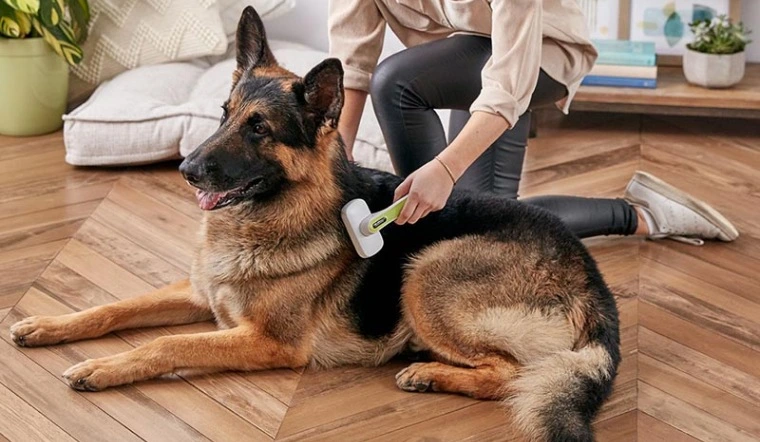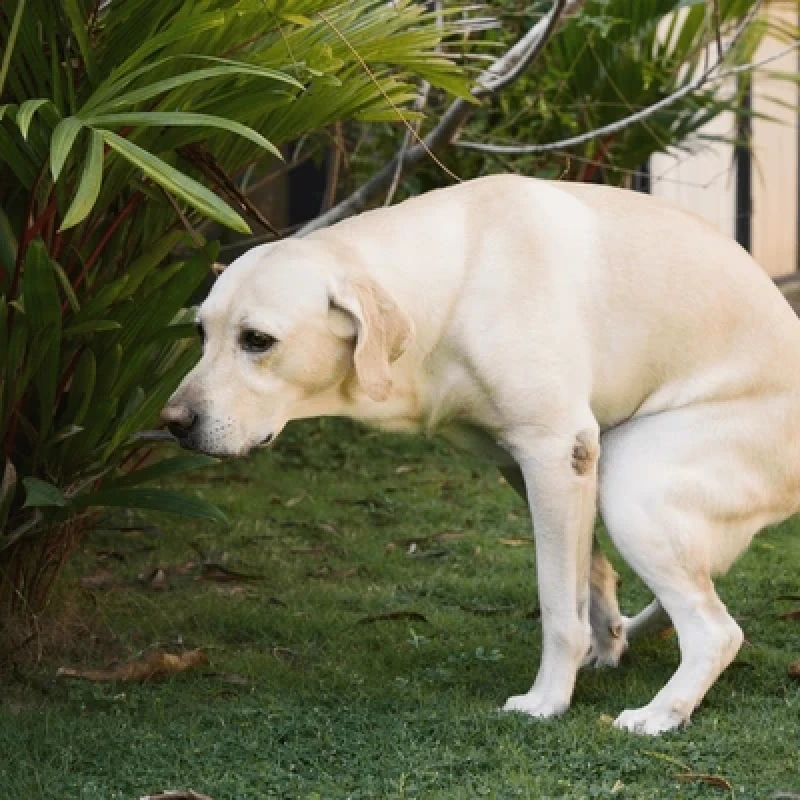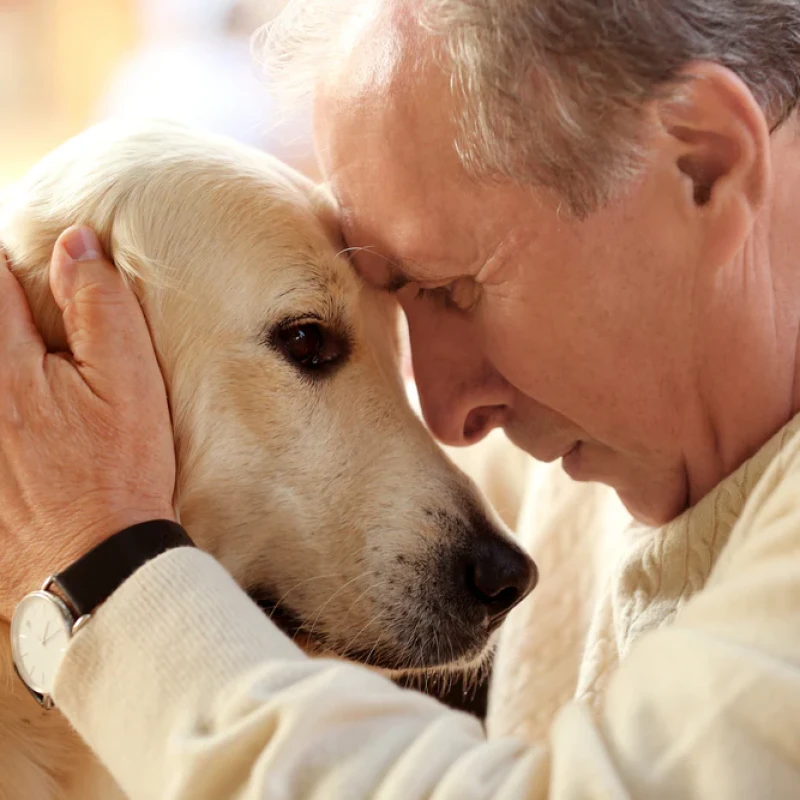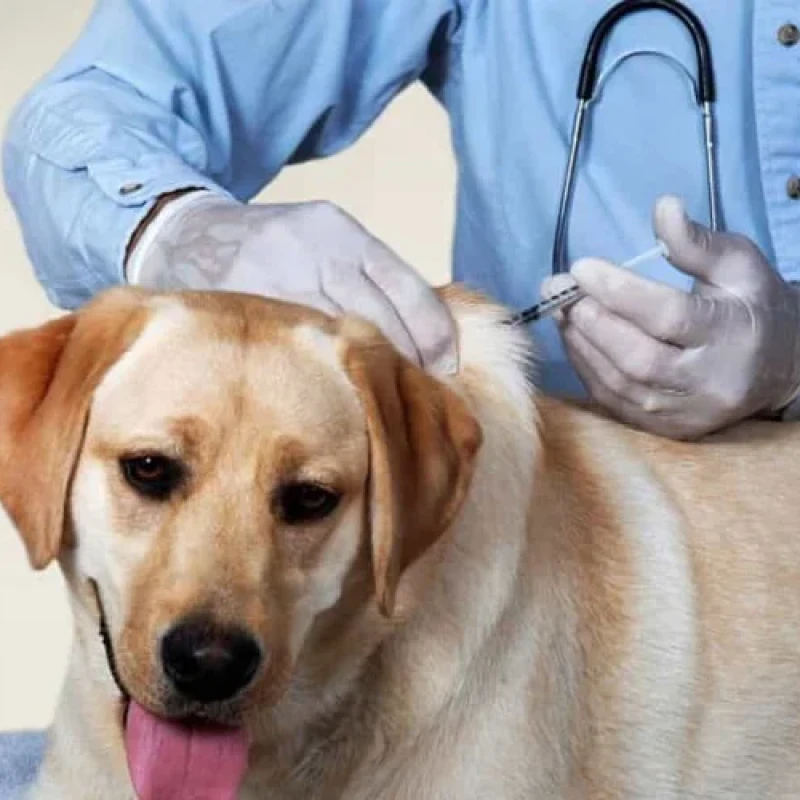Similar to the hair loss process in humans, dogs naturally shed their fur. You can rest assured that even if a dog is shedding, it is still completely healthy. However, if you notice that your dog is shedding excessively, with a thin coat accompanied by other symptoms such as patchy hair loss, continuous itching, or flaky skin, then it is no longer just a physiological issue.

**How Often Do Dogs Shed?**
Most dog breeds shed twice a year.
The first time is at the end of winter when temperatures begin to warm up, and dogs shed their thick coats to cool down. The second time is at the end of autumn when it gets cold, and dogs need to replace their coats to keep warm. This typically occurs between March and May and September and November.
For long-haired breeds, shedding can be more severe. Sometimes, just running your hand down their back can result in a clump of fur coming off. In summer, dog fur tends to be lighter, shorter, and softer, which helps reduce heat. The coat also serves to protect the skin from harmful UV rays from the sun.
In winter, the coat needs to be thick and heavy to maintain the internal body temperature. The winter coat is usually coarse on the outside and soft on the inside, preventing the dog from getting too cold and protecting them from harmful radiation from sunlight.
**Shedding is a Normal Physiological Sign**
Not all shedding is indicative of health problems or poor hygiene. Excessive shedding can often be due to physiological factors and development, commonly referred to as the shedding cycle. Some dogs may shed more as they approach their heat cycle.
Afterward, they will grow a new, softer coat. This characteristic allows you to know when your dog is preparing for physical and physiological changes. Many breeds typically shed and grow new coats twice a year. You can rest assured that this is nothing to worry about.
**Shedding Due to Parasites, Fungi, and Bacteria**
If your dog is infested with parasites, mites, fungi, or bacteria, it will lead to uncomfortable itching. The dog may scratch excessively, resulting in hair loss, bleeding, or flaking skin. Signs include redness around the eyes, nose, ears, and belly, which are commonly seen in breeds like Poodles, Pugs, and Pomeranians. If not addressed properly, this can significantly impact your dog’s health.
First, you should eliminate these parasites immediately. Keep in mind that you need to eradicate not only the adult fleas or ticks but also their eggs. Additionally, you should spray your dog's sleeping area with anti-parasitic medication, especially in corners and hidden spots.
For fungi or bacteria, maintaining cleanliness is crucial to prevent allergies that lead to excessive shedding. If the shedding increases despite these measures, it’s advisable to consult a veterinarian for the best advice.
**Due to Fleas and Ticks**
When infested with parasites, the skin becomes itchy and irritated. This leads to dogs using their paws to scratch the infested areas, causing friction and biting. The affected areas will have coarse, discolored fur that easily breaks and falls out. Flea infestations can result in significant hair loss, which owners may notice in areas where their dogs frequently play.
Parasites can spread from other dogs. However, it’s also common for puppies that are not bathed or groomed regularly to suffer from this.
**Due to Hookworm Infection**
Dogs infected with hookworms will lose weight, have pale mucous membranes, coarse and dull fur that easily breaks and falls out. There will be varying patches of hair loss on the back, exposing the skin, which may show rashes or scabs. Dogs with excessive shedding due to this condition will also lose their appetite, vomit, suffer from pica, experience alternating diarrhea and constipation, and may have bloody or black, foul-smelling stools.
This occurs when owners do not regularly deworm their dogs, leading to worm infestations that cause excessive shedding and can damage the skin, increasing the risk of skin diseases.
**Due to Demodex Mites**
Demodex mites cause a skin condition that primarily affects the head, nose, eyelids, and ears. Sometimes, it may appear on the chest, belly, armpits, thighs, and the side of the tail. It can even lead to patchy hair loss that gradually spreads across the body. The skin will appear red, with red bumps, and the affected areas may thicken due to frequent scratching, friction, and biting.
Demodex primarily forms small bald patches around the eyes and can spread across the body. The affected skin will thicken, form scabs, and may develop small pustules or become a case of pyoderma. Treating dogs with Demodex will also take considerable time.
Why Do Dogs Shed Their Fur?
Dogs typically shed their fur twice a year. The first shedding occurs at the end of winter when temperatures start to warm up, and dogs lose their thick fur layer to cool down. The second shedding happens at the end of autumn when the weather gets colder, and dogs need to replace their fur to stay warm. This usually occurs from March to May and September to November.
For long-haired breeds, shedding can be more severe. Sometimes, just brushing along the spine can result in a clump of fur coming off. In summer, a dog's fur tends to be loose, shorter, and softer, helping to reduce heat. Fur also serves to protect the skin from harmful UV rays from the sun.
In winter, the fur needs to be thick and heavy to retain body heat. The winter coat is usually coarse on the outside and soft on the inside, helping to prevent the dog from getting cold and protecting it from harmful sun rays.
Shedding fur is a normal physiological sign. Just because a dog is shedding fur doesn’t mean it has health problems or poor hygiene. Excessive shedding can be due to physiological factors and growth, often referred to as the shedding cycle. Some dogs may shed more fur as they approach their "heat" cycle.
Afterward, they will grow a new, softer coat. Based on this characteristic, you can anticipate physical and physiological changes in your dog. Many breeds typically shed and replace their fur twice a year, so there’s no need for concern.
Shedding Due to Parasites, Fungi, and Bacteria
If your dog is infested with parasites, mites, fungi, or bacteria, it can lead to itching and discomfort. The dog may scratch excessively, leading to fur loss and even bleeding and skin peeling. Signs include redness in areas around the eyes, nose, ears, and belly. This is often seen in breeds like Poodles, Pugs, and Pomeranians. If left untreated, these issues can significantly affect your dog's health.
First, you should try to eliminate these parasites. It's essential not only to kill the fleas and ticks but also to remove their eggs completely. Additionally, you should spray insecticide in the dog’s sleeping area and surroundings, especially in nooks and crannies.
For fungi or bacteria, maintaining hygiene for your dog is crucial to prevent allergies that can lead to increased shedding. If using these methods results in more shedding, consult a veterinarian for the best advice.
Shedding Due to Fleas and Ticks
When infested with parasites, the skin becomes itchy and irritated. This leads to the dog scratching with its paws, rubbing against surfaces, and biting. Affected areas may have coarse, discolored fur that breaks and falls out easily. Fleas can cause significant hair loss. Owners might notice fur around their dog's favorite spots.
Parasites can spread from other dogs, but unbathed and uncombed dogs are also at risk.
Shedding Due to Hookworm Disease
Dogs with hookworm infections may lose weight, have pale mucous membranes, coarse, dull fur, and experience hair loss in various patches. The skin may show rashes or scabs. Affected dogs may lose their appetite, vomit, have pica, experience alternating diarrhea and constipation, and have bloody or black, foul-smelling stool.
This occurs when owners fail to deworm their dogs regularly, leading to parasitic infections that can cause uncontrolled shedding and skin issues.
Shedding Due to Demodex Mites
Demodex mange is caused by mites that usually appear on the head, muzzle, around the eyes, and ears. It may also spread to the chest, belly, armpits, thighs, and sides. Hair may fall out in patches, leading to redness, lesions, and thickened skin. Scratching and biting the affected areas can result in further hair loss.
Demodex mange primarily causes small patches of hair loss around the eyes, which may spread across the body. Infected skin can thicken and crust, and may develop small pustules or become infected. Treating hair loss due to mange can be time-consuming.
Shedding Due to Nutritional Deficiencies and Hormonal Disorders
Just as humans can lose hair due to nutrient deficiencies, dogs can also shed due to a lack of nutrients, leading to a shiny coat and healthy skin. Essential vitamins and minerals for a dog’s skin and coat include: Biotin (Vitamin H), Zinc, Vitamin A, and Vitamin B. Treatment becomes easier when these nutrients are supplemented daily.
A deficiency in Vitamin B can lead to excessive shedding, weight loss, poor appetite, fatigue, and poor vision. Thus, it’s vital to provide additional vitamins for your dog. Besides commercial dry dog food, fresh food and vegetables can be added to their diet.
Estrogen imbalance is common in unspayed female dogs, leading to overactivity from excess estrogen. They may experience itching and symmetrical fur loss, with darkened skin. In some cases, affected dogs may have swollen genitals, bleeding while urinating, and prolonged heat symptoms. In such cases, it’s best to take the dog to a veterinarian for examination and treatment.
Shedding Due to Poor Grooming and Hygiene
If your dog's sleeping area is not clean or you’re not grooming them properly, this can easily lead to shedding. Not bathing or overbathing can also cause fur loss, especially when using human shampoos that have a high pH.
It's best to use specialized dog shampoos that are most suitable for your dog. Avoid frequently changing their shampoo or conditioner to prevent allergies and further shedding.
When dogs lose fur in patches, they may be more susceptible to infections from itching and scratching. At this stage, their skin is sensitive and thin, requiring special care products. After bathing your dog, you can apply moisturizing powder for their fur and skin. Additionally, natural massage oils can make their fur smoother.
Dogs Losing Fur and Constantly Itching
Are you distressed seeing your dog scratching so much that they are injuring themselves? At this point, what should you do to "soothe" their itching while minimizing skin damage and treating their wounds?
Keep the dog from biting the itchy skin. Use your hands to part the fur and locate the affected area. Use hydrogen peroxide mixed with water. Dip a cloth in this mixture to clean the infected and itchy area. Continue wiping, dipping, and cleaning until the inflamed skin is free from dirt and dry blood.
You can use anti-itch spray on the affected area to alleviate itching. Take a piece of adhesive, apply antibiotic ointment on one side, and stick the medicated side to the inflamed area. Wrap it with medical gauze twice, then secure it with tape.
Use a collar and leash to keep them still for about an hour to prevent licking or biting the tape. Once the itching subsides, spray a bitter solution on the taped area to deter them from licking that spot.
Care During Shedding Season
During shedding season, you should increase the frequency of brushing your dog. If not removed promptly, the old fur can become dirty and matted with new fur, leading to unsightly tangles. This also creates an ideal environment for bacteria and fungi to thrive.
Dog hair can cling to clothing, furniture, and food, causing hygiene issues and affecting human health, particularly for the elderly and young children.
To prevent excessive shedding, you can use specialized grooming tools. Brush your dog at least once or twice daily, especially for long-haired breeds. This helps untangle the fur and remove some dirt.
Seasonal shedding in dogs is normal. However, if you notice abnormal signs such as excessive shedding, red spots on the skin, or dandruff, it may indicate skin diseases. Keep an eye on these symptoms for appropriate treatment.
Guidelines for Dog Fur Care
If your dog is shedding fur, do not feel frustrated or angry. Instead, find appropriate ways to address the issue:
Use a vacuum cleaner to clean your home. Alternatively, you can purchase a small handheld vacuum designed to remove pet hair from furniture and belongings. A lint roller can also help remove hair from clothing.
For optimal fur care, you should regularly trim your dog’s fur. It’s best to use a professional dog grooming service for the best results, ensuring your dog looks neat and attractive. While grooming, check for fleas or ticks by parting their fur and ears for timely treatment.
When brushing, choose soft-bristled brushes designed for dogs. Brush at least once a day, brushing against the fur can help relax them and make them feel more loved.
Additionally, regularly provide nutritious food that is beneficial for their skin and fur. Ensure your dog stays hydrated to prevent dry skin and weak fur that is prone to shedding. To minimize shedding, ensure your dog has access to clean, cool water daily and schedule regular health check-ups for them.
Methods to Help Reduce Dog Hair Allergy
If you experience the following symptoms after coming into contact with dogs or cats, you may be allergic to pet hair:
- Coughing, runny nose, sneezing, itchy nose, and watery eyes.
- Hives in patches.
- Possible conjunctivitis, red and itchy eyes.
For individuals with a history of asthma, allergies to dog or cat hair can trigger acute asthma attacks, leading to shortness of breath and chest tightness. In severe cases, it can even be life-threatening. Up to 30% of asthma patients are related to allergic rhinitis.
If you have a history of asthma, you should absolutely avoid dogs and cats. However, there are still ways to interact with them safely. You just need to take a break from them for a while and then gradually increase your exposure. Here are three methods to ensure you no longer have dog hair allergies:
1. Bathe Your Dog Regularly
Bathing your dog weekly helps reduce the amount of dead skin cells from your pet. When a dog sheds hair, rolls in dirt, or scratches, dust and hair can be released. These can settle on household items like carpets and clothing, even sticking to food. If someone is sensitive to animal hair, they may react immediately, either through direct or indirect contact. Regular bathing and grooming will help minimize this issue.
If you want to keep a dog at home, ensure you bathe it regularly. Choose a suitable shampoo that prevents shedding and eliminates fleas. During shedding season, use a vacuum cleaner to clean your home environment.
2. Create a Safe Distance When Allergic to Dog Hair
While you can't make your home completely allergen-free, you can focus on keeping one room, like the bedroom, free of allergens. Use an air purifier in this area, and consider using waterproof bedding. Avoid allowing pets to roam in living areas where people eat or sleep.
You should vacuum frequently to prevent dog hair from accumulating on household items. Use disinfectant when mopping the floors. After cuddling your dog, wash your hands thoroughly with soap to eliminate any bacteria.
3. Treat Dog Hair Allergy
If having a pet is essential to you, it’s best to consult an allergy specialist. Don’t give up too quickly; try allergy shots, nasal sprays, and other medications. Typically, you can combine specialized treatments as advised by medical professionals, from treatment to bathing and home cleaning. This can make keeping pets in your home more enjoyable, even if you are allergic.
If you decide to have a pet, strive to live in harmony with them. We hope this article helps you prevent allergies related to dog and cat hair. Wishing you and your pet good health!








